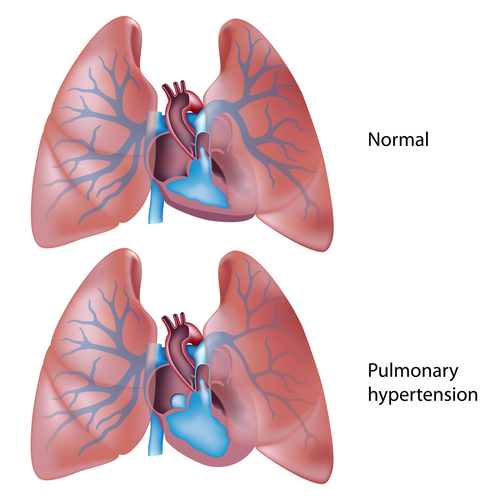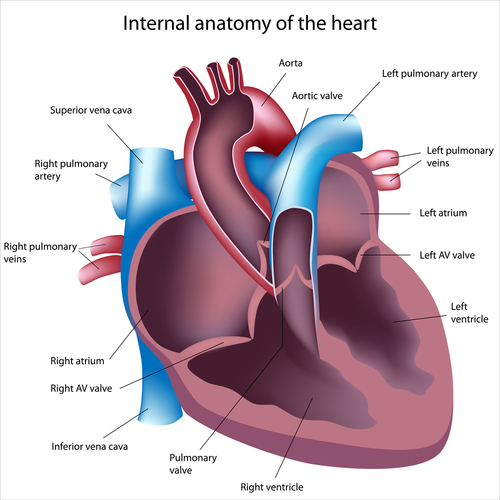 Pulmonary hypertension (PH) is a rare lung disease that refers to an increase in blood pressure in the pulmonary arteries. These are the arteries that carry deoxygenated blood from a person’s heart to the lungs to pick up oxygen. Pulmonary hypertension is a chronic disease that can lead to a poor quality of life. PH can also lead to right heart failure if left without medical intervention, a serious complication that can lead to death. PH is said to be present when blood pressure of the lungs becomes greater than 25 mm of mercury (Hg) when a person is resting, or 30 mm Hg when exercising. Normal pulmonary artery pressure runs between 8 and 20 mm Hg at rest.
Pulmonary hypertension (PH) is a rare lung disease that refers to an increase in blood pressure in the pulmonary arteries. These are the arteries that carry deoxygenated blood from a person’s heart to the lungs to pick up oxygen. Pulmonary hypertension is a chronic disease that can lead to a poor quality of life. PH can also lead to right heart failure if left without medical intervention, a serious complication that can lead to death. PH is said to be present when blood pressure of the lungs becomes greater than 25 mm of mercury (Hg) when a person is resting, or 30 mm Hg when exercising. Normal pulmonary artery pressure runs between 8 and 20 mm Hg at rest.
For people who have been diagnosed with HP years ago, the classification system was divided up into 2 categories known as primary and secondary forms, based on whether a specific cause could be determined. Primary HP was diagnosed if the cause of PH was unknown, and Secondary PH was diagnosed if the increased pulmonary artery pressure was due to some medical condition. In the late nineties, the World Health Organization (WHO) suggested that PH be classified into 5 categories based on similarities of pathophysiology, clinical presentation and medical treatments. The classification system has been revised again in 2003 and 2008. Whether or not PH is primary or secondary or is classified according to the new nomenclature, the disease results in a thickening of the pulmonary arteries, which causes narrowing of these blood vessels. As a result, the right side of the heart has to work harder to pump blood through the highly resistant pulmonary arteries. This causes the heart to become enlarged. As time goes on, over working the right side may cause right-side heart failure, which may result in death.
Pulmonary Hypertension Heart AnatomyUnderstanding The Heart in PH
 For patients who are not familiar with heart and lung anatomy and physiology, some basic information is helpful. The human heart has two sides that are separated by an inner wall, known as the septum. Each side is further divided into an upper and lower compartment. The upper right compartment is known as the right atrium and it receives deoxygenated blood coming back from the body by way of the vena cava. The right atrium passes blood to the right ventricle (lower compartment), and the right ventricle is responsible for pumping blood to the lungs by way of the pulmonary artery. The pulmonary artery branches into capillaries in lung tissue, and this is where carbon dioxide is exchanged for oxygen from the lungs. The capillaries in the lungs turn into the pulmonary veins and these veins carry oxygenated blood back to the heart. Oxygenated blood enters into the left atrium (upper left compartment). The left atrium pumps blood into the left ventricle (left bottom compartment) and the left ventricle pumps blood to the aorta. Oxygenated blood is now available for the whole body.
For patients who are not familiar with heart and lung anatomy and physiology, some basic information is helpful. The human heart has two sides that are separated by an inner wall, known as the septum. Each side is further divided into an upper and lower compartment. The upper right compartment is known as the right atrium and it receives deoxygenated blood coming back from the body by way of the vena cava. The right atrium passes blood to the right ventricle (lower compartment), and the right ventricle is responsible for pumping blood to the lungs by way of the pulmonary artery. The pulmonary artery branches into capillaries in lung tissue, and this is where carbon dioxide is exchanged for oxygen from the lungs. The capillaries in the lungs turn into the pulmonary veins and these veins carry oxygenated blood back to the heart. Oxygenated blood enters into the left atrium (upper left compartment). The left atrium pumps blood into the left ventricle (left bottom compartment) and the left ventricle pumps blood to the aorta. Oxygenated blood is now available for the whole body.
Inflammation and changes in the cells that line the pulmonary arteries can bring about pulmonary hypertension. Inflammation can restrict blood flow due to a smaller blood vessel diameter and the altered cell lining can make the arterial wall stiff not allowing for expansion when needed as blood flow increases. Blood clots are yet again another issue. There are a number of factors that can cause PH and we’ll take a look at those shortly as the causes are related to PH classification. Nevertheless, these arterial changes make it difficult for the heart to pump blood to your lungs and the damaged blood vessels have high resistance to blood flow. This causes the blood pressure in the pulmonary arteries to rise making your heart work even harder and this worsens with time. Eventually the right ventricle becomes enlarged and weak. The right ventricle may become so weak that it can no longer pump blood to the lungs. This results in heart failure and this is the most common cause of death in individuals who have PH.